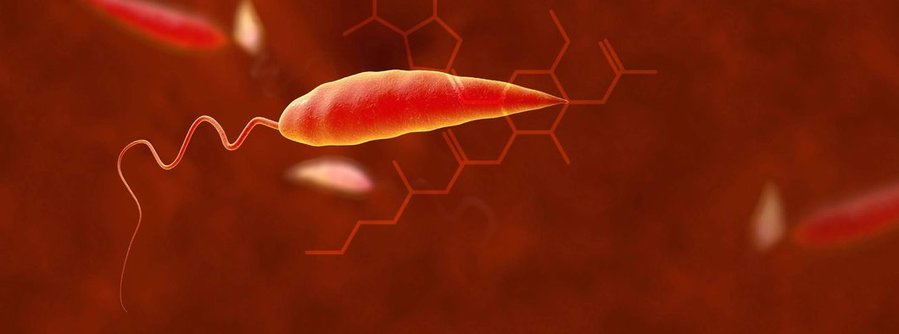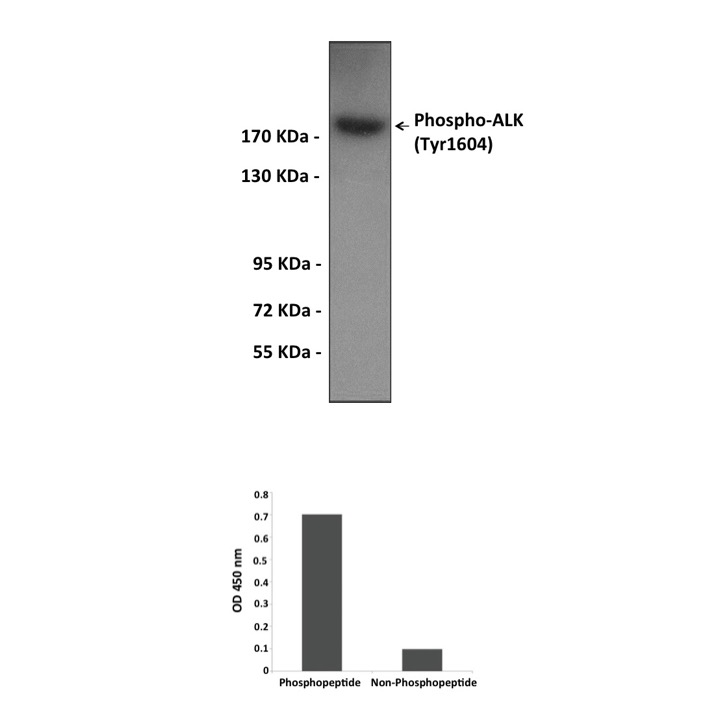Anti-Phospho-ALK: Rabbit ALK, Phospho-Tyr1604 Antibody |
 |
BACKGROUND ALK (anaplastic lymphoma kinase) is a tyrosine kinase receptor, expressed as part of the chimeric NPM-ALK protein, in anaplastic large cell lymphomas (ALCLs) exhibiting the t(2;5)(p23;q35) translocation. As a result of this translocation, the NPM (nucleophosmin) gene is fused to the portion of the ALK gene encoding its intracytoplasmic segment. The fusion with NPM results in activation of the ALK kinase domain and its expression in a deregulated and ectopic manner, both in terms of cell type (lymphoid) and cellular compartment (nucleus and cytoplasm).1 In addition, other ALK fusion protein was also discovered in other cancers including non-small cell lung cancer (NSCLC). ALK inhibitor has produced objective response for treatment of such cancer patients in clinal trials. The ALK receptor TK is most closely related to leukocyte tyrosine kinase (LTK), with which it shows 79% amino acid identity in the kinase domain and extensive homology elsewhere, including the ligand-binding domain. Because its ligand has not yet been identified, it remains an orphan receptor, and its normal function is unknown. The normal ALK expression was essentially limited to the central and peripheral nervous system. Other studies suggested that there may be a limited role for ALK outside the nervous system.2 The ALK signaling pathway is gradually being worked out. NPM-ALK has been shown to activate phospholipase C (PLC)-γ, which accounts for much of the mitogenic effect of NPM-ALK, but not its anti-apoptotic effect. By co-immunoprecipitation, NPM-ALK is also has been found to activate the PI3-kinase/AKT pathway. In addition, NPM-ALK interacts directly with Shc and IRS-1, but these interactions were found to be dispensable for transformation. There is also evidence for direct signaling from NPM-ALK to GRB2, but no GRB2 recognition site has been identified in NPM-ALK. Finally, NPM-ALK may also interact with the STAT5 signaling protein and transcription factor.3
REFERENCES
1. Morris, S.W. et al: Sciences 263:1281-4,1994
2. Lamant, L. et al: Am. J. Pathol. 156:1711-21, 2000
3. Ladanyi, M.: Am. J. Pathol. 157:341-5, 2000
2. Lamant, L. et al: Am. J. Pathol. 156:1711-21, 2000
3. Ladanyi, M.: Am. J. Pathol. 157:341-5, 2000
Products are for research use only. They are not intended for human, animal, or diagnostic applications.
Параметры
Cat.No.: | CG1006 |
Antigen: | Short peptide from human ALK sequence surrounding and containing phospho-Tyr1604. |
Isotype: | Rabbit IgG |
Species & predicted species cross- reactivity ( ): | Human, Rat, Mouse |
Applications & Suggested starting dilutions:* | WB 1:500 - 1:1000 ELISA 1:5000 IP n/d IHC n/d ICC n/d FACS n/d |
Predicted Molecular Weight of protein: | 176 kDa |
Specificity/Sensitivity: | Detects endogenous levels of Phospho-ALK (Tyr1604) proteins without cross-reactivity with other family members. |
Storage: | Store at -20°C, 4°C for frequent use. Avoid repeated freeze-thaw cycles. |
*Optimal working dilutions must be determined by end user.
Документы
Информация представлена исключительно в ознакомительных целях и ни при каких условиях не является публичной офертой








